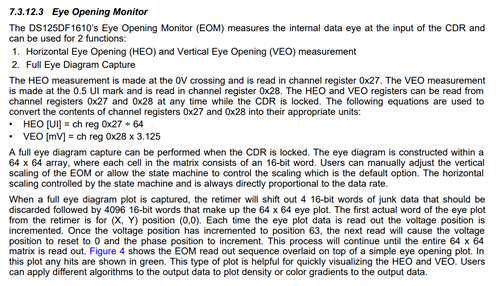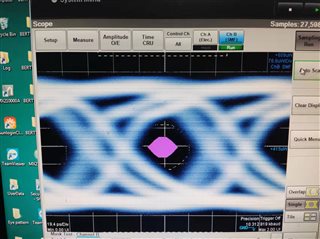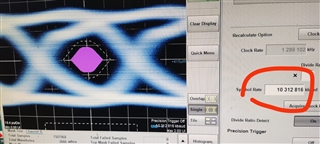Other Parts Discussed in Thread: DS125MB203
Hi TI
The hardware channels are as follows: backplane & LT;=> Ds125df1610 & lt;=> ds125mb203 <=> Panel 10 GBIT/s optical module.It can be configured through i2C channels DS125DF1610 and DS125MB203.
The problem is: the signal from the backplane, whether it is 1G signal, or 10G XFI signal, the panel optical port is not link (self-loop and docking other devices, are not link) DS125DF1610 chip uses the default configuration of power-on, DS125MB203 uses the default value, DS125MB203 registers are as follows:
root@ebang:/$i2cdump -f -y 20 59
0 1 2 3 4 5 6 7 8 9 a b c d e f 0123456789abcdef
00: 08 00 00 00 00 00 10 01 00 00 ff 70 00 00 00 2f ?.....??...p.../
10: ad 82 00 00 00 00 2f ad 82 00 00 00 00 2f ad 82 ??..../??..../??
20: 00 00 00 00 2f ad 82 00 0c 00 00 00 2f ad 82 00 ..../??.?.../??.
30: 00 00 00 2f ad 82 00 00 00 00 2f ad 82 00 00 00 .../??..../??...
40: 00 2f ad 82 00 00 38 00 05 00 00 00 00 00 00 00 ./??..8.?.......
50: 00 46 00 00 00 00 10 64 21 00 54 54 00 00 00 00 .F....?d!.TT....
60: 00 00 00 00 00 00 00 00 00 00 00 00 00 00 00 00 ................
70: 00 00 00 00 00 00 00 00 00 00 00 00 00 00 00 00 ................
80: 00 00 00 00 00 00 00 00 00 00 00 00 00 00 00 00 ................
90: 00 00 00 00 00 00 00 00 00 00 00 00 00 00 00 00 ................
a0: 00 00 00 00 00 00 00 00 00 00 00 00 00 00 00 00 ................
b0: 00 00 00 00 00 00 00 00 00 00 00 00 00 00 00 00 ................
c0: 00 00 00 00 00 00 00 00 00 00 00 00 00 00 00 00 ................
d0: 00 00 00 00 00 00 00 00 00 00 00 00 00 00 00 00 ................
e0: 00 00 00 00 00 00 00 00 00 00 00 00 00 00 00 00 ................
f0: 00 00 00 00 00 00 00 00 00 00 00 00 00 00 00 00 ................
root@ebang:/$^C
Question:
1. Ds125df1610 chip and DS125MB203, do you have pass-through mode or by-pass mode? Because there is no Link at present, I cannot locate the problem of DS125DF1610 chip or DS125MB203?
2. There are many registers in the DS125DF1610 chip. What registers should be configured for the 10G XFI signal from the backplane?
3. The default power-on configuration is used for the DS125DF1610 chip.Other values have been manually configured before, and do not link.
4. I also tried the PIN mode of DS125MB203, but it did not link.
5. Please provide the IBIS model files of DS125DF1610 and DS125MB203 chips.





